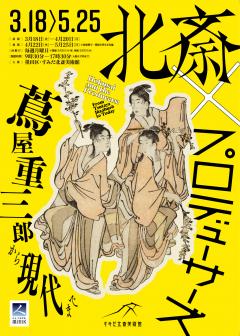Highlights and Composition
1: Tsutaya Jūzaburō, Virtuoso Producer
◆Part1 Tsutaya Jūzaburō I
◆Part2 Tsutaya Jūzaburō II
2: Other Producers Associated with Hokusai
◆Part1 A Long-established Firm from Kyoto: Tsuruya Kiemon
◆Part2 Tsutaya‘s Biggest Rival: Nishimuraya Yohachi
◆Part3 A Nagoya Hero, Eirakuya Tōshirō, and Edo Talent, Kakumaruya Jinsuke
◆Part 4 Iseya Sanjirō, the Hanmoto that Published Hokusai’s Last Nishiki-e Series
◆Part 5 Moriya Jihē: The Leading Bakumatsu Hanmoto
3: The Production of Ukiyo-e Prints Today and Hokusai
Introduction The Hanmoto, the Ukiyo-e Producer
The hanmoto was a business publishing and selling block-printed books and woodblock prints. A hanmoto combined the roles of today’s publisher, distributor, retail bookstore, and used bookstore. Hanmoto in Edo can be divided into two groups, depending on the content they dealt in. Shomotsu donya (mono no honya, “real bookstores”) handled scholarly books. Jihon donya (ezōshiya, “shops with illustrated books”) dealt in popular recreational fiction, including the illustrated books known as kusazōshi, as well as ukiyo-e prints. The hanmoto on which this exhibition focuses belong to the jihon donya category. Because how publications in this recreational category sold was influenced by fads and other social trends, the hanmoto, as producer, needed the ability to track trends and plan publications that customers would want. This introduction explains the basics of ukiyo-e production and sales as a step towards understanding the hanmoto’s work.
.jpg)
Reference illustration: Utagawa Toyokuni III, Artisans, from the series
A Modern-day Match up with Four Estates 1857,
Machida City Museum of Graphic Arts
1: Tsutaya Jūzaburō, Virtuoso Producer
Tsutaya Jūzaburō (nicknamed Tsutajū) began his business in the Shin Yoshiwara licensed quarter, then moved to Nihonbashi, the heart of Edo. His ability to perceive what would appeal to current tastes led him to publish books that became popular sensations, including works by the top kyōka (satirical verse) and gesaku (popular fiction) writers, including Ōta Nanpo (1749-1823) and Santō Kyōden (1761-1816). He also discovered new talent among ukiyo-e masters, such as Kitagawa Utamaro (1753-1806) and Tōshūsai Sharaku (n.d.), thus contributing to the development of Edo culture. After the death of Tsutaya Jūzaburō I, his head assistant took over running the company, and the line continued through the fifth generation, in the Meiji period (1868-1912). This section introduces the influence of the first and second Tsutaya Jūzaburō on Hokusai and the works he created for them, plus related reference materials.
◆Part 1 Tsutaya Jūzaburō I
He was born in the Shin Yoshiwara in 1750. During the An’ei era (1772-81), he opened a bookstore on the Gojikken Road, which led to the entrance to the Shin Yoshiwara. In 1783, he moved to Tōri Aburachō, in Nihonbashi, where he published numerous superb kibyōshi (illustrated popular fiction), collections of kyōka, and other books. He also published nishiki-e, polychrome prints. In 1791, however, Tsutaya published a book by Santō Kyōden that the government then banned, and he was punished with a large fine. To reinvigorate the publishing house back to life, he published nishiki-e by Tōshūsai Sharaku, but he then died, of an illness, in 1797, at the age of 48. It has been confirmed that his work with Hokusai included publishing his early-period nishiki-e and illustrated books, when the artist was using the name Shunrō, and that he actively promoted Hokusai’s work.
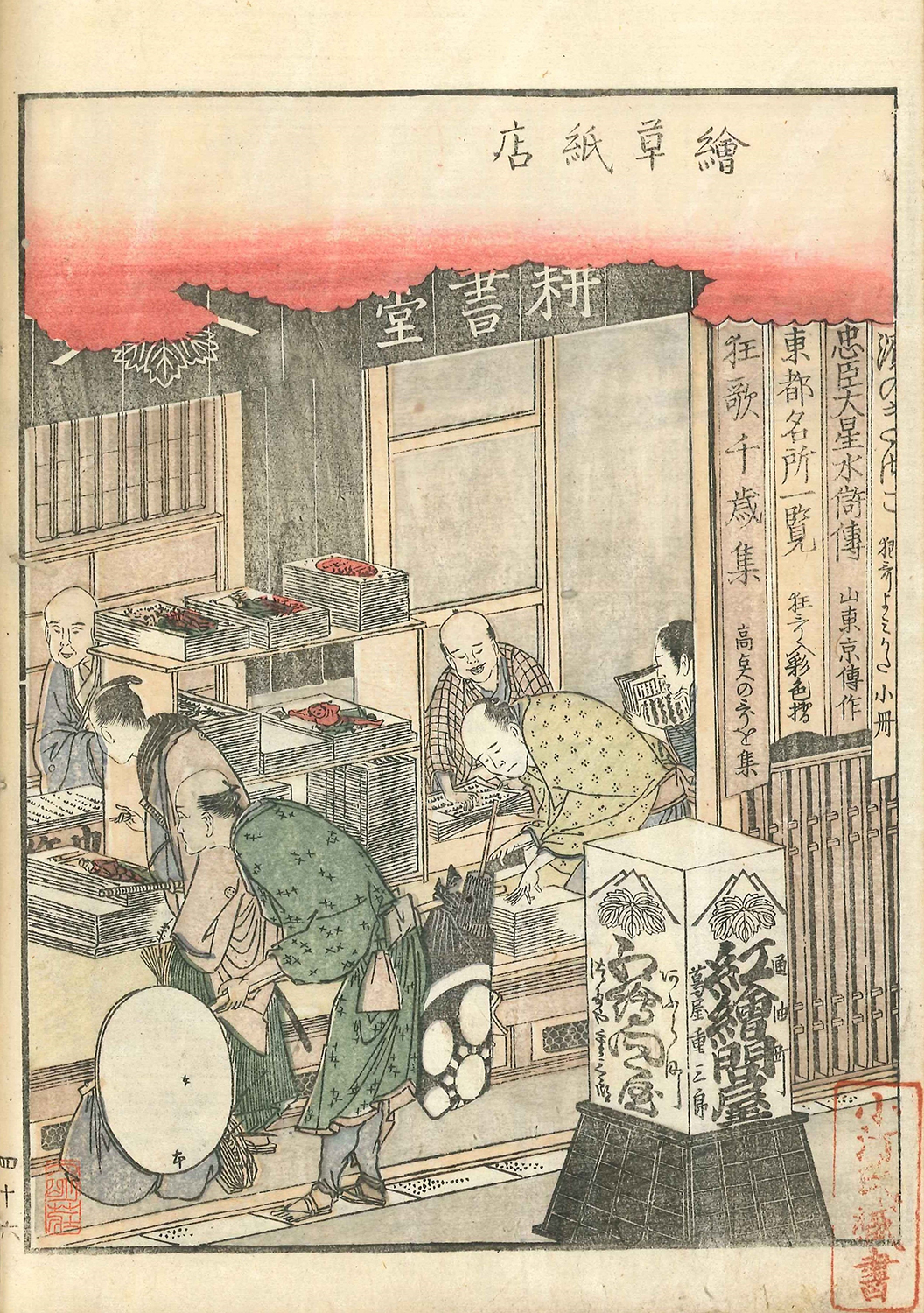.jpg)
Katsushika Hokusai, Print and Picture Book Shop,
from Pleasures of the Eastern Capital, Vol.3 1802,
The Sumida Hokusai Museum (all terms)*
.jpg)
Katsushika Hokusai, Third Month, Contest of Floral Beauty,
from the series Niwaka Festivals of the Twelve Months 1791,
The Sumida Hokusai Museum (2nd term)
◆Part 2 Tsutaya Jūzaburō II
According to Kyokutei Bakin’s diary and other sources, the successor’s actual name was Yūsuke, and he was the cousin of the wife of Iseya Kan’emon (possibly the publisher Igaya Kan’emon). He worked for Tsutaya Jūzaburō I, becoming his top employee. After his master’s death he became adopted son-in-law of the family and carried on the firm as Tsutaya Jūzaburō II. He had more connections to Hokusai than did his predecessor, publishing, one after another, the kibyōshi novels that Hokusai wrote and illustrated, his lavish books of kyōka, and other works.
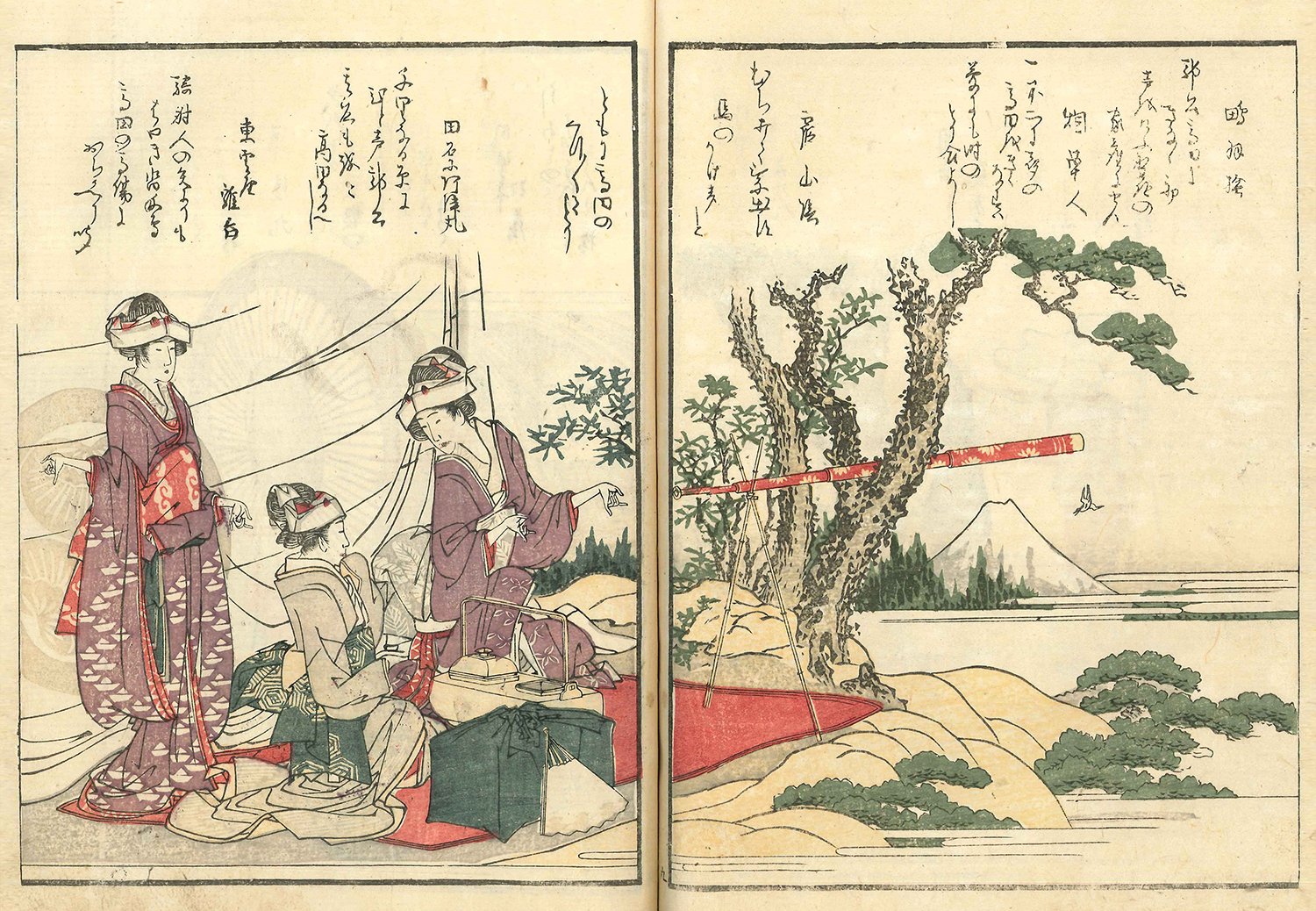.jpg)
Mountain upon Mountains Vol. 1 1804.
The Sumida Hokusai Museum (2nd term)
2 Other Producers Associated with Hokusai
Tracing Hokusai’s career reveals that many publishers besides Tsutaya handled his significant, sometimes iconic, works. Nishimuraya Yohachi published his exemplary series of pictures of famous places, Thirty-six Views of Mount Fuji. Tsuruya Kiemon, a prominent publisher with a long history in Edo, also produced works by Hokusai. Eirakuya Tōshirō, the leading hanmoto in Nagoya, contributed to the birth of Sketches by Hokusai. This section explores, through Hokusai’s works and related materials, the contributions of many producers other than Tsutaya Jūzaburō.
◆Part 1 A Long-established Firm from Kyoto: Tsuruya Kiemon
Tsuruya Kiemon, who had been a shomotsu donya, dealing in scholarly books, in Kyoto, also opened a shop in Edo during the Manji era (1658-61) . He then became a successful jihon donya, dealing in prints and popular fiction. His actual surname was Kobayashi. It was Tsuruya Kiemon III who was heading the firm in Hokusai’s day, with a shop in Tōri Abura-chō, Nihonbashi. This leading hanmoto published the works of all the iconic ukiyo-e artists, including the first ukiyo-e artist, Hishikawa Moronobu (?-1694), Kitagawa Utamaro, and Utagawa Hiroshige (1797-1858). The business then suffered, however, a series of misfortunes, including the sudden death of its head in 1833, a major fire the following year, and, in 1842, during the Tempō Reforms, the banning of a book it had published, Nise Murasaki, Inaka Genji (Fake Murasaki, Yokel Genji) by Ryūtei Tanehiko. Thereafter it went into a decline as an hanmoto publishing new works, focusing instead on wholesale distribution.
◆Part 2 Tsutaya‘s Biggest Rival: Nishimuraya Yohachi
The Nishimuraya was, for three generations, Edo’s preeminent publisher and seller of both scholarly and popular books and prints, beginning in the Hōreki era (1751-64). Their store was in Bakurochō nichōme (now Nihonbashi Bakurochō, Chuo city). Nishimuraya Yohachi II, who succeeded after Yohachi I of Jūzaburō‘s powerful rival, was adopted from Urokogataya Magobē, a long-established hanmoto. His achievements include training Ryūtei Tanehiko (1783-1842) as an author of gōkan illustrated popular fiction and publishing famous prints by Torii Kiyonaga (1752-1815), Utagawa Toyokuni (1768-1825), and Chōbunsai Eishi (1756-1829). His greatest legacy was Hokusai’s Thirty-six Views of Mount Fuji, thereby contributing to the establishment of ukiyo-e landscape prints. During Nishimuraya Yohachi III’s lifetime, it is said, business was bad, and the Nishimuraya left the publishing industry.
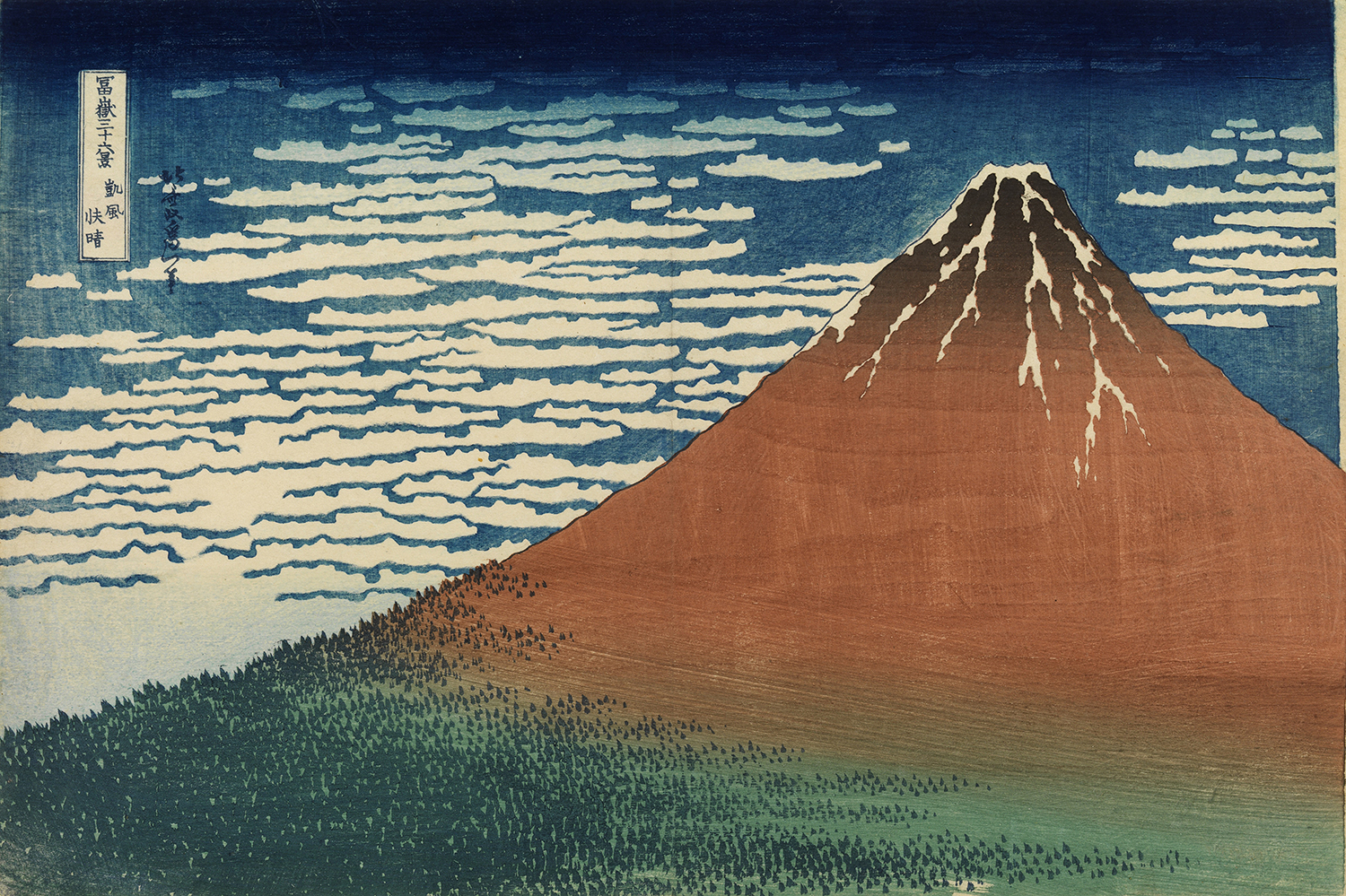.jpg)
from the series Thirty-six Views of Mount Fuji 1831
The Sumida Hokusai Museum (all terms)*
◆Part 3 A Nagoya Hero, Eirakuya Tōshirō, and Edo Talent, Kakumaruya Jinsuke
The Eirakuya, which opened for business in the An’ei era (1772-81), was Nagoya’s leading hanmoto. The second-generation Eirakuya Tōshirō was Hokusai’s contemporary and published Sketches by Hokusai, one of his masterpieces. He cooperated with Tsutaya and opened shops in Mino and Edo as well as Nagoya. The Eirakuya remained in business until 1951. Kakumaruya began as a peddler of geta sandals who used the name Jimbē. During the Kansei era (1789-1801), he opened a shomotsu donya publishing scholarly books in Edo’s Kōjimachi Hirakawachō (now Hirakawachō, Chiyoda city), and stayed in business until the Kōka era (1844-48). The Kakumaruya published a wide range of books, from collections of kyōka (satiric verses), illustrated books, and popular fiction to general educational books. Sketches by Hokusai were jointly published by the Eirakuya and Kakumaruya from the second volume onwards, but later were published by the Eirakuya alone.
◆Part 4 Iseya Sanjirō, the Hanmoto that Published Hokusai’s Last Nishiki-e Series
This new jihon donya, which was founded in the Tempō era (1830-44). The shop was originally in Kodenmachō sanchōme (now Nihonbashi Kodenmachō, Chuo city) but later moved to Honchō sanchōme Shinmichi (now Nihonbashi Muromachi, Chuo city) and other locations. The Iseya published nishiki-e by Utagawa Kunisada (1786-1865) and Utagawa Kuninao (1795-1854). At the end of the Kaei era (1848-54), however, it transferred ownership of the jihon donya to Hamadaya Tokubē. The Iseya was the hanmoto that published Hokusai’s last nishiki-e series, One Hundred Poems Explained by a Nurse.
◆Part 5 Moriya Jihē: The Leading Bakumatsu Hanmoto
The Moriya Jihē jihon donya was founded in the Kansei era (1789-1801). It was nicknamed Moriji. Its shop was in Bakurochō nichōme. The Moriya published works by ukiyo-e masters such as Kitagawa Utamaro, Utagawa Toyokuni, Utagawa Kunisada, and Utagawa Hiroshige. It also produced many ukiyo-e and ranking tables of the then popular spectacles and sideshows. It was the leading hanmoto during Bakumatsu, the closing years of the Tokugawa shogunate, but it had few skillful block carvers. “Moriji’s bad carving” was notorious. Nonetheless, this firm did publish several of Hokusai’s famous works, including his Eight Views of the Ryūkyū Islands, A Thousand Pictures of the Sea, his Imagery of the Poets series, and his vertical ōban series of bird-and-flower prints.
.jpg)
The Sumida Hokusai Museum(1st term)
3 The Production of Ukiyo-e Prints Today and Hokusai
Studios that carry on the traditional techniques of ukiyo-e prints from the Edo period are still active today. Here we introduce works by contemporary artists inspired by Hokusai and published by those studios. Through them, we hope that you will discover Hokusai’s influence and sense that the world of ukiyo-e print techniques remains alive and well today.
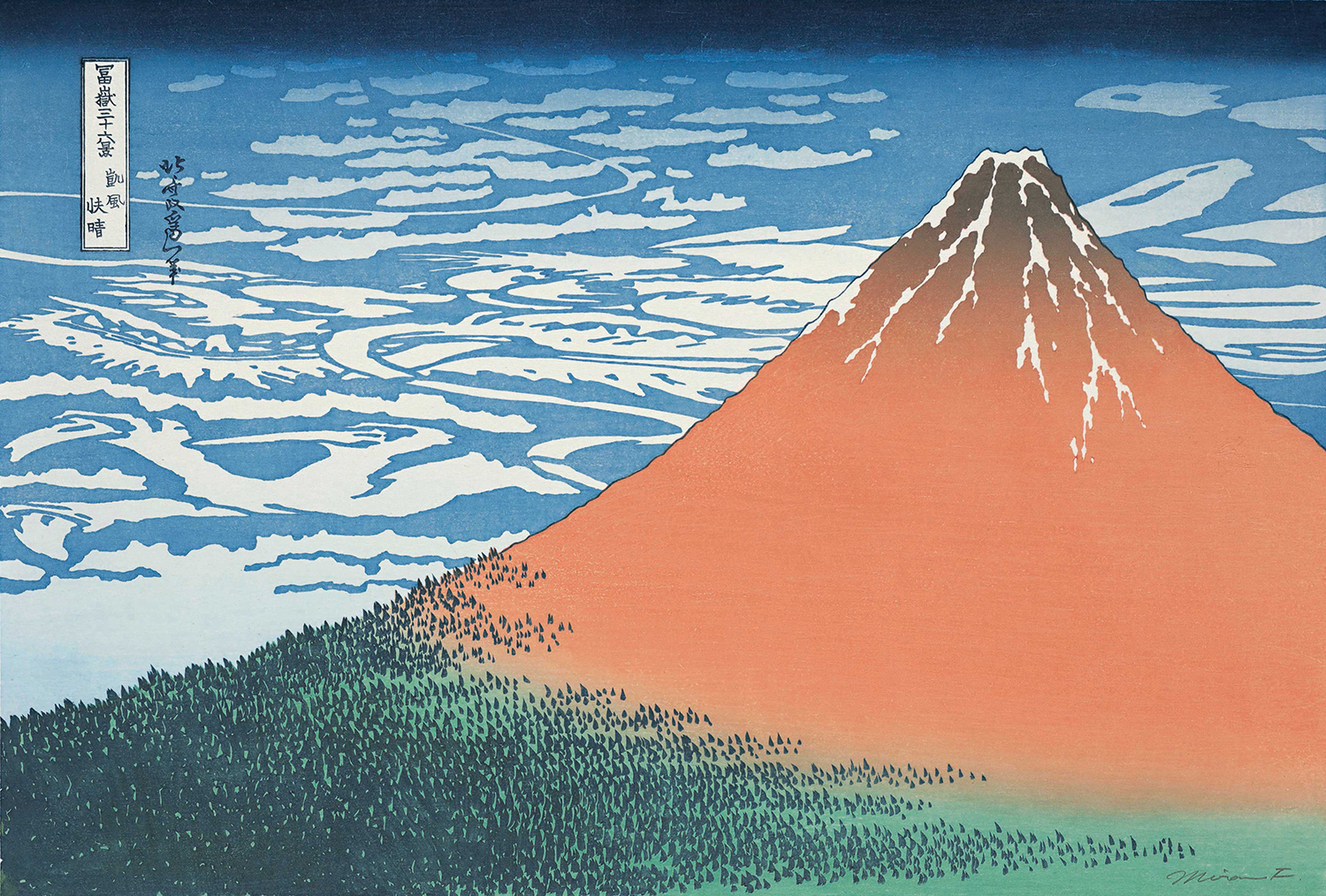.jpg)
from the series Thirty-six Views of Mount Fuji 2021,
The Sumida Hokusai Museum (all terms)*
List of Works
Admission fee
|
|
|
|
|---|---|---|
|
|
|
|
|
|
|
|
|
|
|
|
|
|
|
|
|
|
|
|
|
|
|
|
Tickets are available online for specific dates and times.
Skip the line at reception by booking in advance using the link below.
Note: Availability is limited.
Official Online Ticket site
・Junior high, high school, and university students (including technical college, vocational school, and special training college students) will be requested to show student ID.
・Adults 65 and over will be requested to show a document verifying age.
・Persons with a certificate such as the following plus one accompanying person are admitted at a discount charge: physical disability, intellectual disability, rehabilitation, mentally handicapped health and welfare, atomic bomb victim health notebook, etc. (Please show your certificate at time of admission.)
・Use of these tickets is limited to the day visitors view the exhibiions and allows you to see also "Education Room-Discover Hokusai-" and Permanent Exhibition Plus.
・For group visit, reservation in advance is required. See For Group Visitors.
・For school group visits and field trip programs, reservation in advance is required. See For Teachers.
・After tickets have been purchased, Changes and refunds cannot be made after . However, refunds will be made only in the event of a museum closure due to ineviable force.
Exhibition Leaflet
Original leaflet filled with highlights of the exhibition will be sold from March 18, 2025.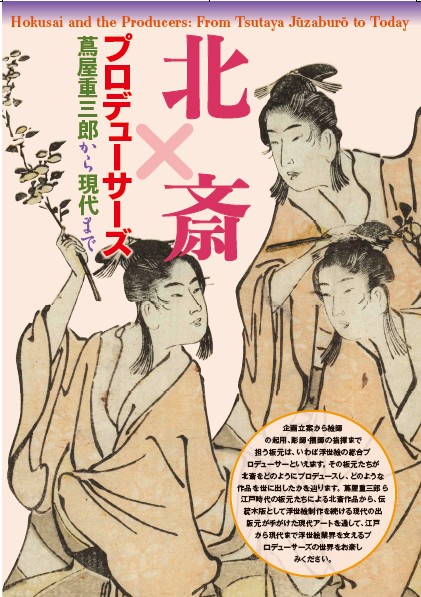
| Title | Hokusai and the Producers: From Tsutaya Jūzaburō to Today |
| Price | ¥350 (tax included) |
| Format | Full Color/A4 size/8 pages in all |
| Release Date | March 18, 2025 |
| Location | Museum Shop, 1F, Sumida Hokusai Museum |
